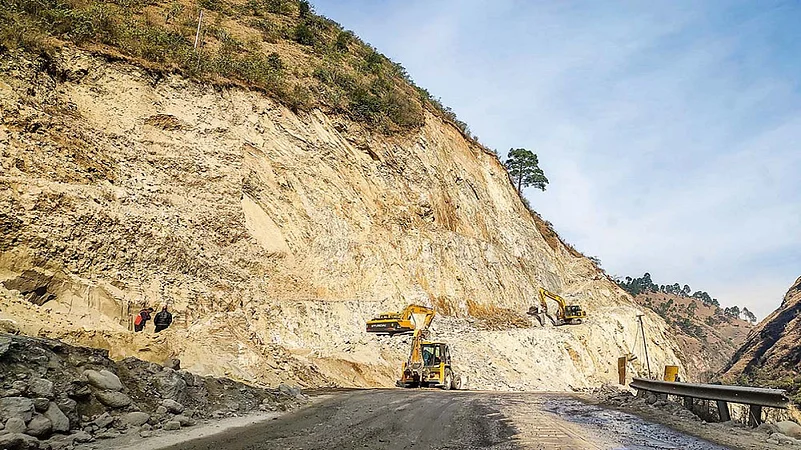Up in the mountains of Himachal Pradesh the traffic stands at a fork. Ahead are two roads, one parading a rich promise, the other flashing ominous signs of an apocalypse. The one tailgating the political will to harness the state’s natural resources sustainably for economic growth has the Supreme Court’s go-ahead. The top court cleared 605 projects in the state on February 15, the green light for men in hi-vis jackets and work helmets to press forward with their equipment—shovels, bulldozers, jackhammers and dynamites for stubborn rocks and clay, and chainsaws for millions of trees standing on the way. There are dams to be built to extract electricity; there are roads to be widened for lorry convoys to efficiently ship apples and fruits of labour of farmers in far-flung valleys and hillsides to markets in the nation’s ravenous plains. There is money to be made. The ancient rocks and their sentinel deodars and pines are roadblocks in cold projections of political-economists. But not for environment experts, the rocks and trees are the foundation of the ecosystem that is as fragile as a man against a bullet. And so, signs on the other road betray perils of man’s quest to tame nature—the glacial burst at Chamoli in neighbouring Uttarakhand is the latest grim reminder.
All that is not lost on chief minister Jai Ram Thakur. “We have the environmental concerns in mind. These projects are important for development, creating new facilities and meeting public demand. After the Uttarakhand tragedy, I have told the officers to study the safety of all hydel projects and dams, and ensure periodic monitoring. The glaciers are receding fast in the Himalayan region. That too must be kept in mind,” he said after welcoming the top court’s order allowing the projects, environmental clearances granted under forest conservation and rights laws. Some of these projects involve building new bus stands, colleges, sewerage treatment plants, cowsheds, and bridges—unlikely to threaten the ecology. But what about cutting trees and scrapping the mountainside to build a Rs-150-crore Shiv Dham in the ancient and archaeologically significant town of Mandi, the CM’s home district? The plan is to build a replica of the 12 Jyotirlingas dedicated to Shiva and a helipad has come up already next to the green hillside chosen for the dham.
It’s common knowledge that trees—and their wide network of hardy roots—protect the soil from erosion and that no retainer wall, however much rebars, stones and concrete go into it, can stop landslides if natural foundations are tampered/compromised. This is what environmentalists fear might happen to the Rs 1,337–crore four-lane national highway to be built as an alternative route to Shimla’s apple belt. It is called the “green corridor”, but more than 2,200 trees are likely to be sacrificed, more than 50 hectares of forests will be diverted to make way for 104-km road connecting the industrial town of Paonta Sahib with Hatkoti—giving apple growers of Chopal, Nerva, Rohru and Jubbal-Kotkhai easy access to wholesale markets. The existing road is ill-maintained, narrow, cause accidents, prone to landslides and is often iced over in winter, says Balbir Verma, a two-time MLA for Chopal, a place wrestling with three decades of deforestation and timber smugglers. It had the best forests, but construction of roads, clearing trees for farms and orchards and other development projects led to the loss of significant green cover, unlikely to be revived, says Yoginder Chandra, Chopal’s former MLA. “Destruction of forests triggers landslides, flash floods. No environmental impact assessment is done and there is a complete lack of monitoring of these projects pre- or post-implementation.”
A case in point is the Shimla-Parwanoo four-lane project. In the works since 2011-12, around 25,000 trees have been felled while massive slicing, blasting and cutting of the mountainside cause landslides, accidents and deaths every year. Falling rocks along the Parwanoo-Solan stretch is a common hazard that motorists face. The Kiratpur–Bilaspur-Mandi–Kullu-Manali four-lane project is another environmental disaster waiting to explode. Among the projects cleared by the Supreme Court is a ropeway in Manali that has been hanging fire for several years because of ecological concerns, the two-lane NH 20A for Dharamshala and the Rs 46.80-crore Dhaulasidh hydel project, the first in Hamirpur district.
Himachal is a hydro engineer’s paradise—abundant rivers to turn turbines and power an industrial revolution. The state plans to harness 24,000MW from its capacity of 27,436MW. But the state sits on a highly seismic zone, and the Himalayas are as fickle as a wayward teenager. And yet, a pack of hydel projects were sanctioned in high-altitude regions of Lahaul-Spiti, Kinnaur and Chamba in the Sutlej, Chenab and Ravi river basins. Approximately 49 of them with a capacity of 4,032MW have been sanctioned close to the snowline and glaciers in the Chenab valley. The red flags are abundant too. There is more than enough empirical evidence, scientific studies and expert committee reports to establish the detrimental effects of hydel projects in the mountainous, particularly para-glacial, terrains, says Avay Shukla, a retired IAS officer who headed the high court-appointed committee to study environmental impact of such projects. He points to the 300MW Jispa project, a 200m-high dam at an altitude of 3,245 metres that will submerge 12 villages, barely 10km from the Gepang Gath glacier, the state’s largest. “Himachal Pradesh has already seen it, and Chamoli is fresh,” he says.
No doubt, locals as well as environmentalists are unhappy with at least six projects sanctioned in Lahaul-Spiti, including two on Chandra and Bagha—two glacier-fed rivers that form the Chenab. “Ours is a fragile ecology, distinctive soil and different climate .We want roads, water and sewage but not big dams and interference with nature. The forests will be cut, mountains blasted…there will be displacements and a large influx of people,” says Sonam Dorje, 72, a resident of Tandi, Lahaul. The situation in Kinnaur and Chamba districts are equally worrying. Shukla says four mega hydel projects along 70km of the Ravi could cause the river to disappear eventually. Similar fears hang around the Kishau dam on the Tons, a tributary of the Yamuna.
Dams pack a two-punch blow: one, the blasting, tunneling and road construction result in landslides, permanent loosening and fracturing of the strata, deforestation, drying up of aquifers and water sources; two, the monstrous quantities of muck produced by these activities ultimately find their way to the rivers, raising their beds and squeezing them, reducing their capacity to carry water and debris, causing massive floods downstream when extreme events occur. Rishiganga at Chamoli was for all to see.
By Ashwani Sharma in Shimla


























